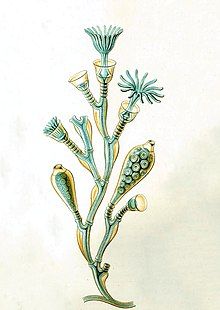
source
Obelia is an invertebrate belongs to Cnidaria phylum. It has two life stage and they are asexual immobile stage and sexual motile stage. Asexual stage is called Obelia colony and sexual stage is called medusa. When the colony is young, it is monomorphic because it has only one zooid called polyp. After maturing the polyps, another zooid, blastostyle arises from the axis of the mature zooids. Then it turns into dimorphic colony because the colony has two zooids named polyps and blastostyles. Inside the blastostyles, medusa buds develop and after maturing the buds, they detach from the blastostyle and swim freely in the surrounding water. After the medusa born, the dimorphic colony becomes trimorphic because it has three zooids named polyp, blastostyle and medusa.
Polyps are the feeding zooid of the Obelia colony. It has tentacles and with the help of these tentacles, polyps prey and eat their food. Tentacles has nematocysts or preying organs. Polyps prey food and eat them. Food digest both extracellularly and intracellulary. The digested food is then served to the whole colony.
Blastostyles are the reproductive zooids of the Obelia colony. Young colony doesn't have blastostyles. After maturing the colony, they arises from the axis of the polyps. Medusa buds develop gradually inside the blastostyles and after maturing the medusa buds, they detach from the blastostyles and come out to the surrounding water through gonopore.
Medusa are the motile sexual zooids of the Obelia. They swim freely. Both the male and female medusa releases gametes to the surrounding water. After releasing the gametes, the parent medusa die soon. Gametes fuse together and form a new Obelia colony.
You can get more information about Obelia from here.
Learn about 11 fun facts of Labeo rohita
Read More:
Respiratory System of Scoliodon